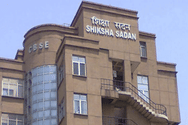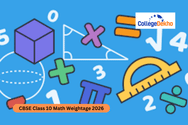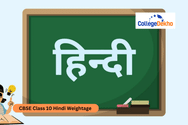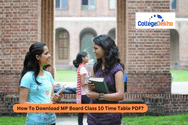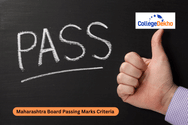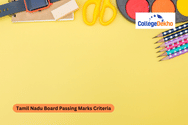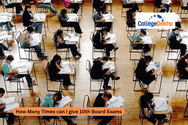

Never Miss an Exam Update
CBSE Class 10 Practical Exam Syllabus 2026: The Central Board of Secondary Education (CBSE) released the CBSE 10th syllabus 2025-26 for both theory and internal assessment/practical exams on its official website. The board conducts an 80 marks theory exam and 20 marks of internal assessments or practical exams, depending on the subject. Language papers and Mathematics will have 20 marks for internal assessments, while subjects like Science and Social Science will have practical exams. Also read: CBSE Class 10 Practical Exam Date Sheet 2026
The CBSE Board is all set to introduce a Two-Exam Policy for Class 10 students starting in 2026 that will allow you to retain the better score. It is mandatory to get 33% marks combined in both theory and practical exams to pass the CBSE Board class 10 examinations. CBSE Class 10 practical exams 2026 for the winter-bound schools will be held in November/December 2025. The practical exams for all other schools will be conducted in January/February 2026. You will also have a viva voce component included in the internal assessment/practical exam for all the subjects. Check more details here.
CBSE Class 10 Latest Updates 2026
- October 31, 2025: The Central Board of Secondary Education has released the final PDF of the CBSE Class 10 Date Sheet 2026 on October 30, 2025. The class 10th first phase will be held from February 17 to March 10, 2026.
Which subjects have practical exams in CBSE Class 10?
The CBSE Class 10 practicals are an important part of the assessment process for students who are studying in the CBSE-affiliated schools. The practical exams are usually held in the school lab by the school teacher or subject experts. The subjects for which practical exams will be conducted are as follows:- Science (Physics, Chemistry, and Biology)
- Some vocational subjects like Information Technology and Home Science
- Computer Applications
- Physical Education
- Language papers (English, Hindi, Bengali)
- Mathematics
- Social Science
CBSE Class 10 Practical Exam Syllabus 2026
The subject-wise CBSE Class 10 Practical Exam Syllabus for the academic year 2025-2026 is mentioned below:CBSE Class 10 Practical Exam Syllabus 2026 for Science
-
A. Finding the pH of the following samples by using pH paper/universal indicator: Unit-I
(i) Dilute Hydrochloric Acid
(ii) Dilute NaOH solution
(iii) Dilute Ethanoic Acid solution
(iv) Lemon juice
(v) Water
(vi) Dilute Hydrogen Carbonate solution -
Studying the properties of acids and bases (HCl & NaOH) on the basis of their reaction with:
Unit-I
a) Litmus solution (Blue/Red)
b) Zinc metal
c) Solid sodium carbonate -
Performing and observing the following reactions and classifying them into: Unit-I
A. Combination reaction
B. Decomposition reaction
C. Displacement reaction
D. Double displacement reaction
(i) Action of water on quicklime
(ii) Action of heat on ferrous sulphate crystals
(iii) Iron nails kept in copper sulphate solution
(iv) Reaction between sodium sulphate and barium chloride solutions -
Observing the action of Zn, Fe, Cu and Al metals on the following salt solutions: Unit-I
i) ZnSO4(aq)
ii) FeSO4(aq)
iii) CuSO4(aq)
iv) Al2 (SO4)3(aq)
Arranging Zn, Fe, Cu and Al (metals) in the decreasing order of reactivity based on the above result. - Studying the dependence of potential difference (V) across a resistor on the current (I) passing through it and determine its resistance. Also plotting a graph between V and I. Unit-IV
- Determination of the equivalent resistance of two resistors when connected in series and parallel. Unit-IV
- Preparing a temporary mount of a leaf peel to show stomata. Unit- II
- Experimentally show that carbon dioxide is given out during respiration. Unit-II
-
Study of the following properties of acetic acid (ethanoic acid): Unit- I
i) Odour
ii) solubility in water
iii) effect on litmus
iv) reaction with Sodium Hydrogen Carbonate - Study of the comparative cleaning capacity of a sample of soap in soft and hard water. Unit- I
-
Determination of the focal length of: Unit-III
i) Concave mirror
ii) Convex lens
by obtaining the image of a distant object. - Tracing the path of a ray of light passing through a rectangular glass slab for different angles of incidence. Measure the angle of incidence, angle of refraction, angle of emergence and interpret the result. Unit - III
-
Studying (a) binary fission in Amoeba, and (b) budding in yeast and Hydra with the help of
prepared slides. Unit-II - Tracing the path of the rays of light through a glass prism. Unit-III
- Identification of the different parts of an embryo of a dicot seed (Pea, gram or red kidney bean). Unit-II
CBSE Class 10 Practical Exam Syllabus 2026 for Computer Applications
| S. No. | Unit Name | Marks |
|---|---|---|
| 1. | Lab Test (20 marks) | — |
| — | HTML (design one web page based on a diagram) | 20 |
| 2. | Report File + viva (20 marks) | — |
| — | Report file: At least 10 HTML pages | 15 |
| — | Viva voce (based on the report file) | 5 |
| 3. | Project (that uses most of the concepts that have been learnt) (10 marks) | — |
| — | Total (50 marks) | — |
CBSE Class 10 Practical Exam Syllabus 2026 for English
- Listening and Speaking Competencies
- Assessment of Listening and Speaking Skills
- It is recommended that listening and speaking skills should be regularly practiced.
- Art-integrated projects based on activities like Role Play, Skit, Dramatization etc. must be used
CBSE Class 10 Practical Exam Syllabus 2026 for Mathematics
- Pen Paper Test and Multiple Assessment
- Portfolio
- Lab Practical (Lab activities to be done from the prescribed books)
CBSE Class 10 Practical Exam Syllabus 2026 for Social Science
- Pen Paper Test
- Quiz, debate, role play, viva, group discussion, visual expression, interactive bulletin boards, gallery walks, exit cards, concept maps, peer assessment, Self- assessment etc. through Interdisciplinary project
- Project Work on Consumer Rights OR Social Issues OR Sustainable Development (Interdisciplinary)
- Classwork, Work done (activities/assignments): reflections, narrations, journals, etc. Achievements of the student in the subject throughout the year Participation of the student in different activities like heritage India quiz
How are Class 10 Practical Exams Conducted by CBSE?
CBSE Class 10 practical exams are conducted by the CBSE Board in all the CBSE-affiliated schools. This exam involves both internal and external examiners. External examiners are appointed for practical exams and project assessments in each school. Schools can not appoint any external examiners on their own; they are appointed by the CBSE. Practical exams in CBSE Class 10 are only conducted for subjects that have a practical component. For the non-practical subjects, there will be internal assessments. Practical exams are conducted in the school's laboratories or allocated spaces for subjects like fine arts.Examiners must ensure the correct marks are recorded, as no adjustments are allowed after the results are finalized. Schools will have to upload the marks on the day when private students have their exams. The marks will be uploaded through a designated online portal, and the process involves steps for previewing and finalizing the marks.
CBSE Class 10 Practical Exam Marking Scheme 2026
The marking scheme for CBSE Class 10 Practical Exam is available for few subjects. We have provided the CBSE Class 10 Practical Exam marking scheme for those subjects below:CBSE Class 10 Practical Exam Marking Scheme 2026 for Mathematics
| Particulars | Marks |
|---|---|
| Pen Paper Test and Multiple Assessment (5+5) | 10 marks |
| Portfolio | 05 marks |
| Lab Practical (Lab activities to be done from the prescribed books) | 05 marks |
CBSE Class 10 Practical Exam Marking Scheme 2026 for Science
| Particulars | Marks |
|---|---|
| Periodic Assessment | 05 marks + 05 marks |
| Practical Work | 05 marks |
| Portfolio | 05 marks |
| Total | 20 marks |
CBSE Class 10 Practical Exam Marking Scheme 2026 for Social Science
| Type of Assessment | Description | Marks |
|---|---|---|
| Periodic Assessment | Pen Paper Test. | 5 |
| Multiple Assessment | Quiz, debate, role play, viva, group discussion, visual expression, interactive bulletin boards, gallery walks, exit cards, concept maps, peer assessment, Self-assessment etc. through Interdisciplinary project | 5 |
| Subject Enrichment Activity | Project Work on Consumer Rights OR Social Issues OR Sustainable Development (Interdisciplinary) | 5 |
| Portfolio | Classwork, Work done (activities/ assignments) reflections, narrations, journals, etc. Achievements of the student in the subject throughout the year Participation of the student in different activities like heritage India quiz | 5 |
Also Check CBSE Class 10 Social Science Exam Pattern 2026
CBSE Guidelines for Practical Exams 2026
The important guidelines that are released by the CBSE Board for CBSE Class 10 practical exams are listed below:
- As per the instruction by CBSE, schools will have to ensure that the syllabus for practical exam is completed on time.
- Schools will have to complete all required preparations on time, including laboratory preparation, stocking, and identification of Internal Examiners.
- School must also ensure that all students along with their parents are aware of the CBSE 10th practical exam date sheet 2026.
- Only external examiners who are appointed by the CBSE board can conduct the Class 10 practical exams.
- The online system will be implemented to check the list of candidates (LOC) who are appearing for the school’s practical examinations.
- Moreover, schools affiliated with CBSE Board must ensure that the correct subjects and student categories (for example, regular, compartment, and improvement) are reflected in the online system.
- Also, if anyone fails to appear for the CBSE 10th practical exam, the board will not provide any second chance to the them. So they have to appear for the practicals as per the proposed schedule.
Are you feeling lost and unsure about what career path to take after completing 12th standard?
Say goodbye to confusion and hello to a bright future!

FAQs
You need to score at least 33% marks (Grade higher than E) in each subject. This applies to subjects without practical components as well as in the practical based subjects. You need 33% in theory and 33% in practical components separately, where applicable, in addition to 33% overall to pass a subject.
Was this article helpful?












